Gaining Support for Your Cause: 9 Campaign Canvassing Tips
As a leader of your advocacy organization, you know the importance of running energetic, dynamic campaigns that build momentum and keep your cause top-of-mind. You also know that your volunteers, while dedicated, are a limited resource and their door-to-door canvassing efforts can only cover so much ground during election season.
Make the most of each interaction your volunteers have with voters by implementing modern campaign canvassing strategies. This guide will help you learn more about running a successful canvassing campaign by diving into the following topics:
- What is campaign canvassing?
- What are the benefits of campaign canvassing?
- 9 Tips for Campaign Canvassing
Effective canvassing has the power to sway elections, expand your organization’s support network, and earn donations that can help further your mission. Over the years, campaign canvassing has transformed in response to new technology and changes in the needs of political and advocacy groups. By leveraging modern technology and your volunteers’ passion, you can transform your advocacy efforts for the better.
What is campaign canvassing?
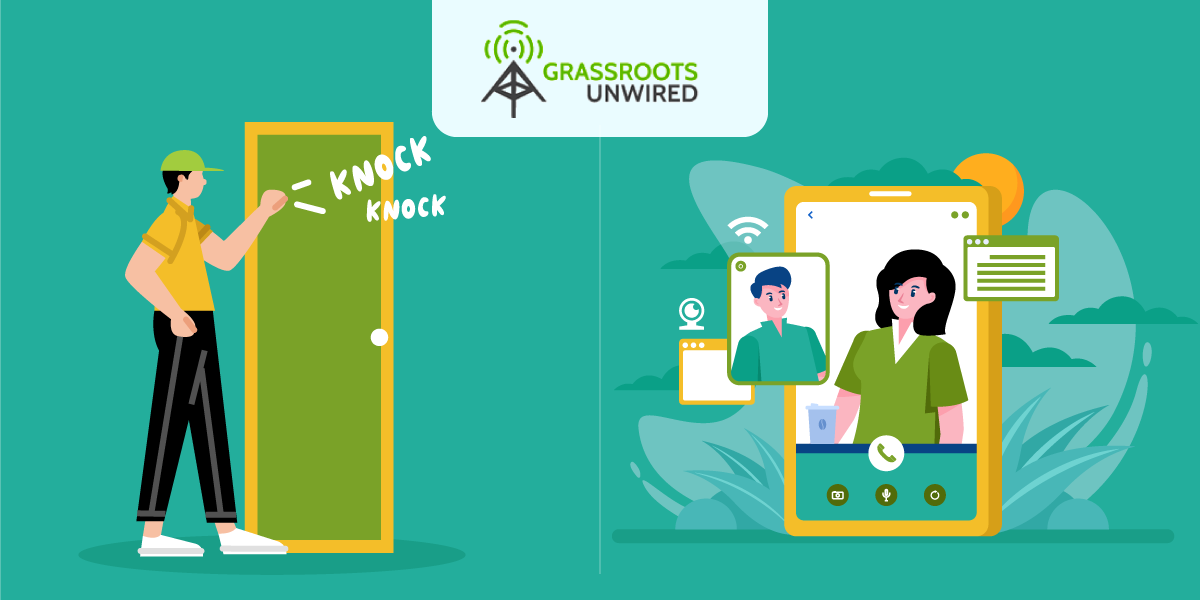
Generally, campaign canvassing refers to the act of going door-to-door to engage with members of your community and persuade them to support your campaign or cause.
Campaign canvassing is conducted by political and advocacy groups, and is most often carried out by volunteers. Depending on the campaign’s purpose, volunteers might encourage individuals to vote for a specific candidate, sign a petition, or make a donation.
With the development of new advocacy technology, in-person campaign canvassing has been streamlined and canvassing can now be handled virtually.
What are the benefits of campaign canvassing?
Campaign canvassing can help your advocacy campaign in multiple ways, allowing you to:
- Increase awareness of your cause. Since you’ll engage and discuss your campaign with many individuals, you’ll naturally increase awareness of your cause.
- Connect with new supporters. As you canvass and spread information about your campaign, you’ll build rapport with new potential donors and encourage them to support your cause.
- Solidify concrete support. During your canvassing campaign, take the opportunity to secure concrete support. Supporters might pledge to donate to your cause, promise to vote for a specific candidate, or otherwise lend their assistance. With modern canvassing tools, you can even facilitate the donation process, have supporters sign up for your newsletter, or secure volunteer registrations during your initial conversations.
- Receive feedback on your campaign. Gain a greater understanding of your community’s attitudes and stances toward your cause as a whole. Take this knowledge and adjust your strategy to appeal to a greater number of individuals.
Aside from these benefits, campaign canvassing is also an opportunity to strengthen your relationship with existing supporters. For these individuals, your volunteers can focus less on persuading them to join your cause and more on discussing the issues they care about. Provide updates on your campaign, discuss recent relevant events, and ask if they will continue supporting your cause.
9 Tips for Campaign Canvassing
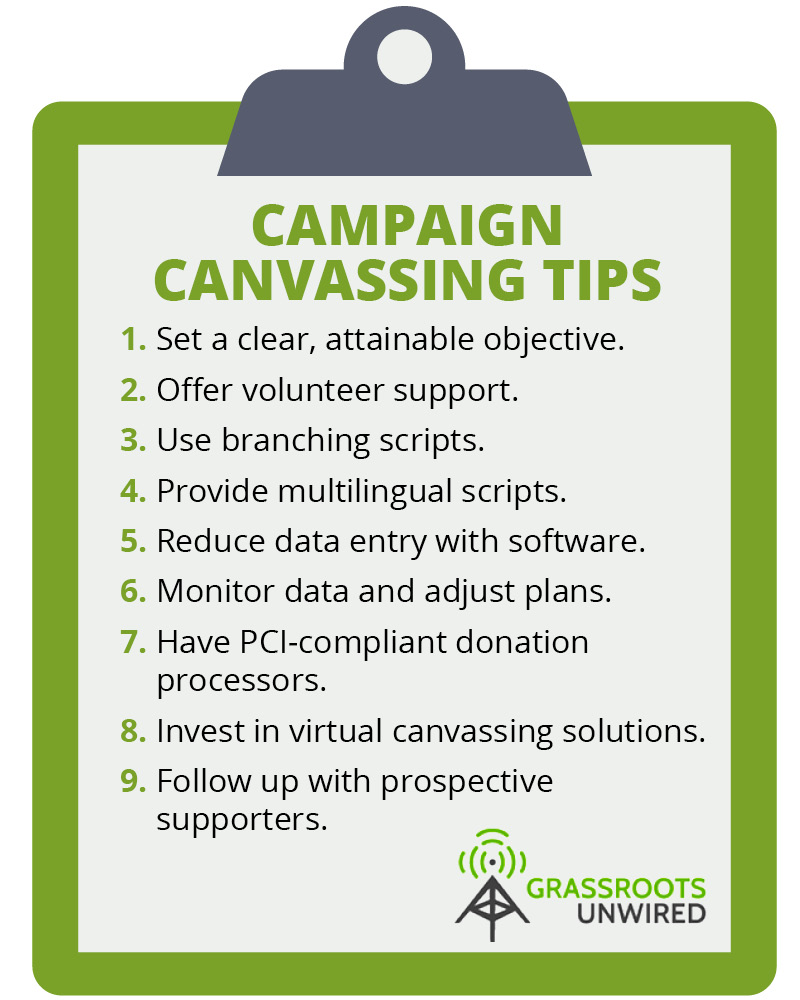
Now that you know the basics, let’s dive into nine campaign canvassing tips. While not all canvassing tips can be applied to every organization, the ones in this guide aim to equip advocacy leaders with a new, strategic approach to traditional door-to-door canvassing.
1. Set a clear, attainable objective.
Sending your volunteers off to start canvassing without a clear goal will result in disorganization and confused volunteers. Avoid this by clearly establishing attainable goals for both individual volunteers and your advocacy group as a whole.
When you set an objective for your campaign canvassing efforts, make sure it meets the following SMART criteria:
- Specific. While your campaign likely has a broad, overarching goal of reaching out to more voters or earning donations, don’t hesitate to choose a specific quantitative goal. For example, you might base your goals on your community’s past participation and determine that you want to see a 15% increase in donations this year.
- Measurable. Some goals, such as “spreading awareness,” are difficult to measure. Without quantitative data, it can be difficult to know whether you have achieved your goal. Ensure your main goals are quantifiable so you can assess your progress throughout your campaign.
- Attainable. You could ask your volunteers to earn donations from 100% of the individuals they speak with. But logically, this goal is impossible for even the most passionate volunteers. Examine your past data and set attainable goals that aim for incremental, realistic improvements.
- Relevant. Set goals for volunteers that align with your canvassing campaign’s overall goal, which should also align with your organization’s mission. Consider what your organization needs most right now. Is it to earn donations, attract supporters, confirm voters, or something else? Determine what that objective is and make sure it is reflected in your volunteers’ day-to-day goals.
- Timely. Most canvassing campaigns have a built-in deadline of an election or policy decision date, but you should still set additional review deadlines to evaluate your progress. Doing so allows you to stay updated on your campaign’s status and determine if your initial goals are still appropriate and achievable.
To make the most of your goal, you’ll need tools to measure your progress. Use your advocacy software to track incoming data and leverage it to create reports that show your campaign progress.
2. Offer extensive volunteer support.
Every volunteer on your canvassing team should receive extensive onboarding before approaching potential supporters about your cause. Train your volunteers to help them speak with a variety of supporters about your mission, and share onboarding materials that explain your campaign’s purpose in detail.
Even after volunteers are fully trained and onboarded, you should continue providing them with support and supervision. Here are just a few ways you can support your volunteers:
- Train them on how to use new software. Advocacy software can transform your campaign and is constantly evolving and improving. Whenever your preferred advocacy or canvassing software goes through a major update, walk volunteers through any changes to get ahead of technical errors that might occur in the field.
- Provide an easy way to get in contact with a manager. Even the most well-trained volunteers will sometimes encounter issues that can be better solved by a supervisor stepping in. Ensure you have someone on staff who your volunteers can contact for help when they’re canvassing.
- Have them canvass in their home communities. Door-to-door canvassing tends to be more effective if individuals know the person knocking on their door. Assign volunteers to cover their own communities when possible, and be mindful of their travel limitations.
Along with presenting a more professional front to prospective supporters, training your volunteers will improve their experience working for your advocacy organization. Then, the next time you host a campaign, you’ll likely have plenty of previous volunteers sign up. As they’ve already undergone training, your organization will save time and resources.
3. Use branching scripts.
While speaking with potential supporters during door-to-door canvassing, your volunteers will likely be asked a few recurring questions. During training, have your volunteers memorize a few key phrases and notable facts about your campaign. Branching scripts can help supplement other conversations that might occur.
While you can’t predict every scenario that will occur during campaign canvassing, you can use reports from volunteers and other data to prepare scripts that include common topics. Construct scripts that encourage open conversations with potential supporters. Here are some best practices to follow:
- Avoid yes or no questions. Yes or no questions can lead to a stilted conversation dominated by your volunteers. By contrast, asking open-ended questions encourages individuals to start talking about their personal experiences and how they relate to your campaign’s cause.
- Work in convincing arguments. Ultimately, your volunteers are attempting to persuade each person they talk to into taking a certain action. Ensure that your script naturally leads back to your strongest arguments in favor of supporting your campaign to sway your audience.
- Encourage volunteers to step away from the script when appropriate. Even with the help of branching scripts, volunteers may end up discussing a topic your scripts don’t account for. Provide your volunteers with a few strategies for bringing conversations back to your campaign, and encourage them to improvise within reason when the situation calls for it.
Of course, your volunteers shouldn’t carry around a huge script while campaign canvassing—you wouldn’t want them to get stuck flipping through pages while in the middle of a conversation with a supporter. Use canvassing software to go digital and make various script paths easy to access with the press of a button.
4. Provide multilingual scripts.
Reach more audiences by providing your multilingual volunteers with multilingual scripts to guide them when sharing your campaign with non-English speakers. Determine what languages will be the most useful for each community you canvass, and create translated scripts for each language you need.
Additionally, consider teaching your English-only volunteers a few key phrases if they are canvassing a community that heavily uses another language. While they may be limited in how much they can carry on the conversation, a few phrases can help direct individuals to a fellow volunteer who can speak with them or to your website to learn more.
5. Leverage software to reduce data entry.
Traditionally, campaign canvassing volunteers have used clipboards and pens to record information about the individuals they meet. However, they have their downsides. Volunteers may struggle to decipher difficult handwriting and will have to enter pages worth of information into your database each day.
The right advocacy software eliminates both of these problems, allowing supporters to enter their information straight into your system. Be sure to integrate your canvassing software with your main database, so that all of your data flows seamlessly from one system to another.
Investing in software saves your team time on repetitive administrative tasks like data entry, improving efficiency and allowing you to move straight to following up with donors and analyzing data trends.
6. Monitor your data and adjust your plans accordingly.
Throughout your canvassing campaign, your volunteers will collect a lot of data. Put this information to use by analyzing your reports and identifying key trends that emerge. For example, while looking over daily reports, you might discover that some of your volunteers are more effective at gathering support from certain communities or areas than others. With this knowledge, you can reassign your volunteers to turfs that best suit their skill set, increasing your chances to attract more supporters to your cause.
Additionally, take the time to clean your database. Outdated and duplicate data can build up over the course of your campaign, so implementing data hygiene measures such as deleting duplicate information, removing unnecessary or trivial information fields, and standardizing data entry practices ensures your database stays usable long-term.
7. Use a PCI-compliant donation processor.
In addition to spreading the word about your mission and encouraging supporters to vote a certain way, your canvassing campaign may also raise funds for your organization. Supporters will likely want to give in a variety of ways, and you should be equipped to accommodate all of them with secure, PCI-compliant donation processors.
Providing multiple donation options increases your overall chances of receiving a gift from a supporter. Here are a few ways you can accept donations that your organization should have ready before your canvassing campaign starts:
- Your website. Make sure your advocacy website supports all the hard work your volunteers put into encouraging people to get involved with your organization. Create a clear navigation system complete with a large, brightly colored donation button so there’s no mistake about how to donate once visitors reach your website.
- A text-to-give number or donation app. It’s likely most people your volunteers talk to will have a cell phone on hand. When your volunteers request a donation, have them mention your text-to-give number or donation app to let supporters know they can give right then and there.
- Your canvassing platform. Virtual canvassing software arms your volunteers with the ability to walk donors through every step of their canvassing process and accept a donation at the end, all through the same platform.
When researching payment processors, prioritize security above all else. By keeping your donors’ financial information safe, your organization can establish trust and lay the groundwork for future monetary contributions.
8. Invest in virtual canvassing solutions.
In addition to in-person door-to-door canvassing, your advocacy organization can also engage volunteers in remote digital canvassing. This will help diversify your campaign canvassing efforts, and virtual canvassing allows your team to reach supporters quickly without needing to travel to their location. With virtual software solutions, volunteers can set up face-to-face meetings over video conferencing tools and conduct the same conversations they would in person.
When browsing potential virtual canvassing solutions, look for a platform that includes the following features:
- Email and SMS follow-up. Grow your network by using your software’s communication tools to stay in touch with supporters after your canvassing campaign.
- Turf-cutting and canvasser management. Manage all of your volunteers remotely by dividing responsibilities evenly among your digital canvassers and supervising them virtually.
- Real-time reporting. Stay on top of your campaign by monitoring your volunteers’ progress in real-time. This allows you to adjust your tactics throughout your campaign to take advantage of new opportunities or prepare for challenges.
- Script branching. Give your digital canvassers the tools they need with a virtual canvassing script that accommodates their unique, online approach.
- Multilingual scripts. Ensure that your campaign canvassing software has a multilingual script functionality to help you reach more supporters.
- Donation processing. Ask for, accept, and process donations with one software solution by finding a virtual canvassing platform with a donation processor.
- Integration with VAN. Integrate your canvassing software with top advocacy platforms like VAN to keep all of your data organized in one place.
- Scalability. Ensure your canvassing software can grow with your organization, whether you’re a local grassroots group or an enterprise-sized organization operating across multiple states.
Research your options and approach potential providers with questions about how their virtual canvassing platform can help your campaign. Then, to make sure it’s a perfect fit, ask for a demo to explore each canvassing solution.
9. Follow up with prospective supporters.
Your canvassing campaigns allow your advocacy organization to collect key data about people in your community, such as their addresses, phone numbers, and email addresses. Your volunteers may persuade some of them to follow through on certain actions after their first interactions, but many will need additional follow-up conversations.
When you follow up with a potential supporter after your canvassing campaign, build on the groundwork laid by your canvassers by:
- Personalizing the conversation. Put the data your volunteers collected to use by addressing each prospect by name, referencing their past conversations with your volunteers, and following up on courses of action discussed during your canvassing campaign.
- Making an ask based on their previous feedback. Your volunteers should take notes about what kind of support each person they spoke with seemed most open to. For example, if someone seemed open to donating but unsure about the amounts suggested by the volunteer, consider asking for a slightly lower donation.
- Saying thank you. Whether someone is able to give or not, make sure to thank them for speaking with you. Each interaction helps strengthen your relationship, and a person who isn’t ready to give the first time you call them may change their mind later on after learning more about your organization.
Additionally, don’t forget to thank your volunteers after your campaign. Show your appreciation by saying thank you, hosting volunteer events, and giving them extra merchandise such as t-shirts, hats, and water bottles. This will help you retain volunteers from campaign to campaign.
Conclusion and Additional Resources
By following the canvassing tips in this guide, you can elevate your campaign canvassing efforts, support your volunteers, and expand your network faster with digital solutions. Take inventory of your current campaign practices to see what you can improve on, and implement the canvassing tips and best practices that address your needs. Don’t be afraid to adjust them based on the specifics of your team, community, and campaign.
Broaden your knowledge of canvassing campaigns even further by learning more about advocacy. Here are a few articles advocacy leaders might find especially useful for their next canvassing campaign:
- Community Advocacy: The Complete Guide to Mobilize Change. Advocacy work is important on many different levels and starts in your local community. This guide will help you gain a deeper understanding of community advocacy.
- Advocacy Software: 14 Top Platforms to Inspire Action. The right advocacy software can help keep your campaign organized and up-to-date. Learn more about 14 different advocacy platforms.
- Political Campaign Software: 9 Tools to Manage Your Campaign. Political campaign software is constantly evolving to help organizations connect with voters. Consider these nine tools and how they can help your efforts.
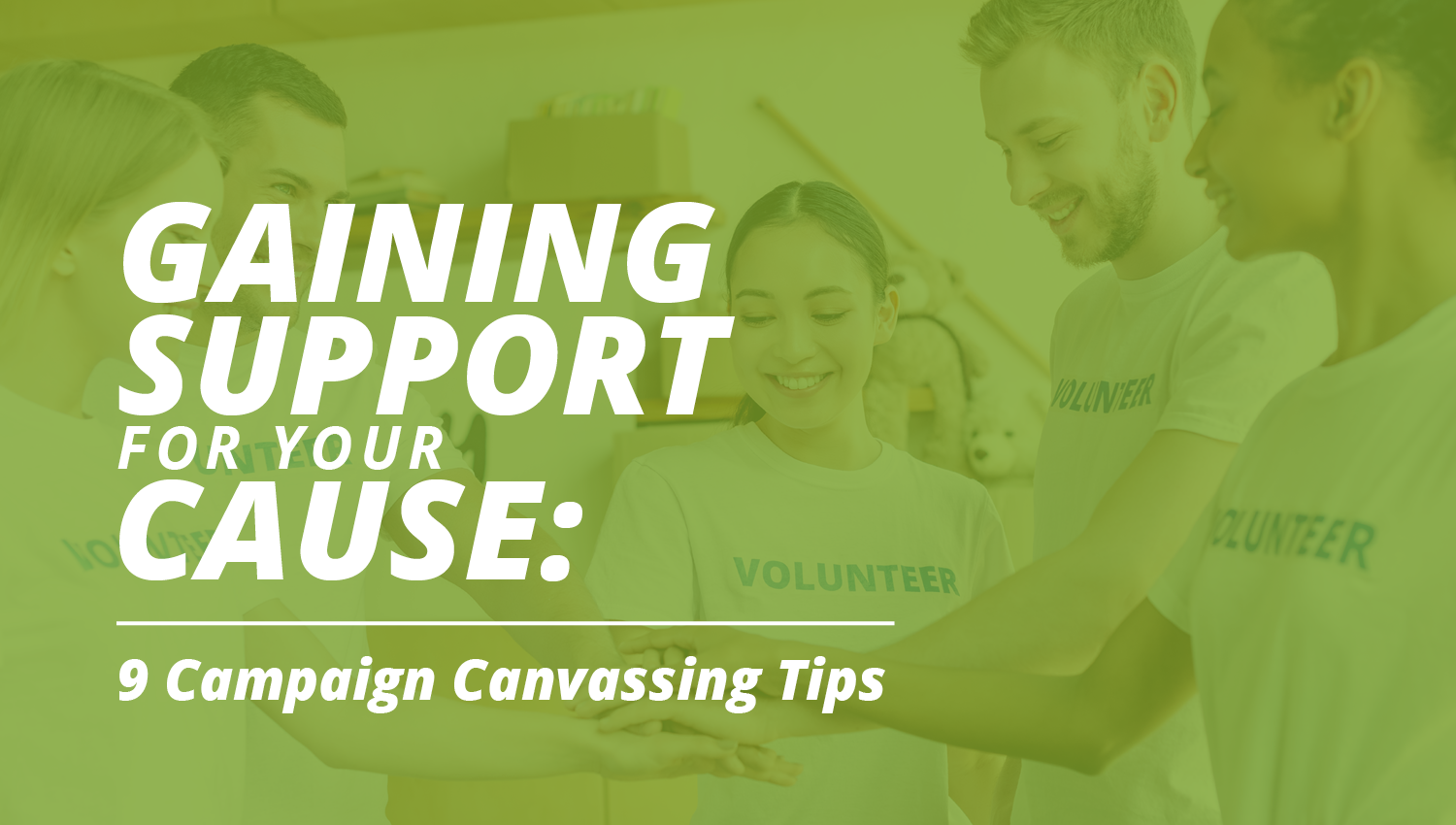

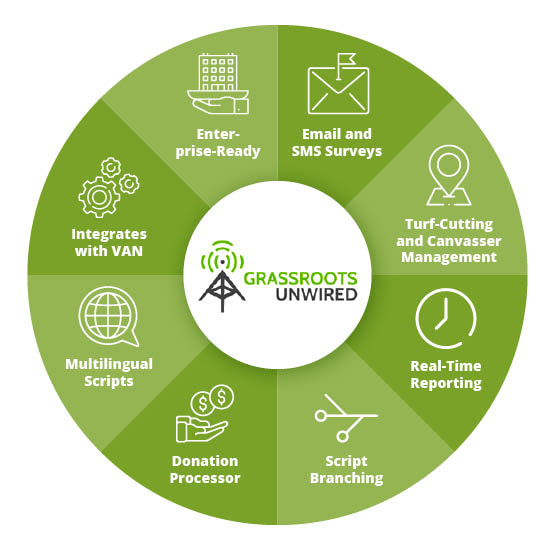
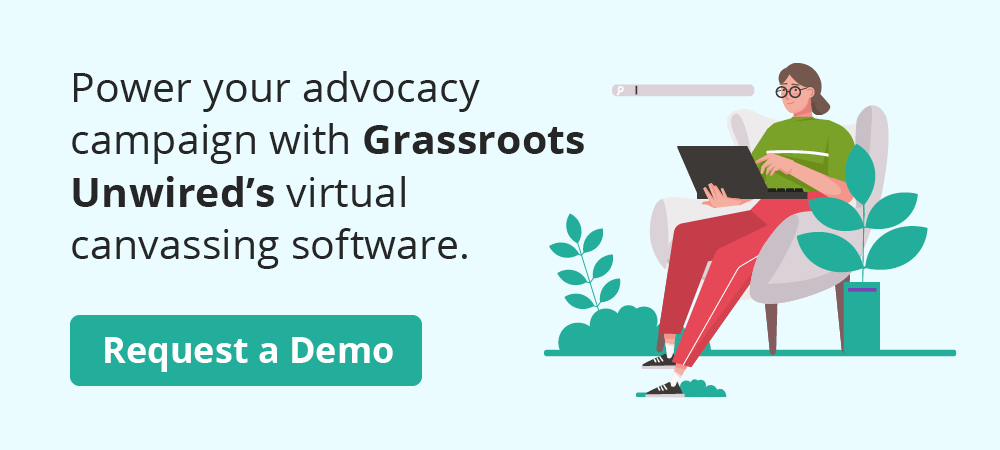
3 Comments so far
5 Tips for Online Engagement – Social Media BlogPosted on1:44 pm - Jun 4, 2022
[…] potential to leverage supporters’ networks. As Grassroots Unwired’s article on canvassing tips explains, supporters are inclined to seize extra leads to your trigger when they’re reaching […]
Grow Your Supporter Network: 4 Tips to Attract Volunteers – Communicate!Posted on7:21 am - Jun 27, 2022
[…] their supervisor, and ask if they can work in a role better suited to their strengths. For example, Grassroots Unwired’s canvassing tips guide discusses how canvassers tend to do better when volunteering in their home communities, due to […]
Using A Predictive Dialer for Deep Canvassing Political Dialing CampaignsPosted on9:02 am - May 31, 2023
[…] following canvassing tips can help your deep canvassing […]